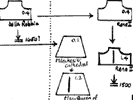CHAPTER 7: Controversies and Misunderstandings
16 of 17 - That there was a mediæval dulcimer
2 Middle Ages
2.2 Europe
2.2.1 Iconology
There is no shortage of psalteries in the mediaeval period: witness, for instance, Galpin's comments on the Cantigas de Santa Maria (58), and Hellquist's study on Church Art in Sweden. They come in all shapes and sizes - Marcuse's classification has no discernable structure and suggests no pattern of development, so is of limited value here (59) - and a variety of techniques are used for playing and holding them.
However, most examples are quite clearly differentiated from dulcimers by being held against the chest and by being plucked with fingers or a quill, and having strings in a single plane, undivided by a bridge.
fig. 253
One main area where there are differences of view is where the plectra are as large as dulcimer hammers, and appear to be made of wood, (fig. 253), and certainly the difference between artifices - a plectrum and a hammer - is a difference of degree, not of kind. But the difference between their uses - striking and plucking - is, on the other hand, a difference of kind: striking implies that the tool used changes direction after it has pushed the string away from the player, and it is the change of direction which leaves the string free to vibrate; plucking, on the other hand, consists of pulling the string away, and continuing in the same direction until the tool slips off the string leaving it free to vibrate - only then does the finger or plectrum change direction (fig.256).
The value of this analysis is that one can make a judgement in each debatable case, as to whether the way the tool is being held is more amenable to pulling-and-sliding past (= plucking, = psaltery) or to pushing-and-rebounding (= striking, = dulcimer, at this stage in history). On the basis of this consideration, the illustrations of several instruments which have been identified as dulcimers because of their large plectra, are in this study treated as psalteries and not discussed here: Hubert Boone considered the illustrations reproduced here in figs. 251-255 to show Hakkebords (60) but they all appear to me to be without doubt psalteries.
fig. 256
It is perfectly feasible to think that these 'psalteries' with extra-large plectra might in fact form a group or type on their own, seen to be related to either the dulcimer or psaltery, or to both, perhaps a distinct stage in the evolution from one to the other. Certainly these instruments - and indeed all the psalteries - deserve a specialised study on the scale of the present one, but with so much virgin ground to be covered it was decided that an exploration of 'psalteries' which might or might not turn out to be 'dulcimers' had to be given less priority than those instruments about which there was little or no doubt, and it was in the event not undertaken.
Some authors consider certain selected trapezoid psalteries to be relevant to the history of the dulcimer, although their basis of selection is not clear. The rationale seems to be that, since in later times instruments called psaltérion and salterio were plucked and trapezoid, any earlier plucked trapezoid instruments must therefore be forerunners. On such a premise, icons such as Lucca della Robbia's chancel carvings in Florence cathedral are included in histories of the dulcimer (61).
Logical as this may sound, it seems to me to be fallacious, because it takes account only of external shape, and not of stringing and bridging. Not sufficient data has been collected to establish with certainty how the various forms developed one from another (if they did), and indeed it may never be possible to do so; but the typological evidence suggests that from plucked, one-plane psalteries developed struck one-plane psalteries, to which bridges were then added to make the strings easier to hit; then a second bridge and string-crossing were introduced, to provide a bass range without increasing the size; and only then were bridged instruments again plucked. This hypothesis is shown in diagrammatic form in fig. 257.
fig. 257
Thus the link between trapezoid or pig's head psalteries, and dulcimers, is no greater than with any other-shaped psaltery: all are ancestors, of course, but the bridging and stringing of 16th century (and later) psaltérions were devised to accommodate hammering, and the geneology must take account of this.
Geiser 1973 shows an instrument on the Portico de la Gloria of the Cathedral of Santiago de Compostela in Spain; Sachs apparently based his migration theory on this carving, although it is hard to see, even on his own terms and ignoring questions of stringing and bridging, why this example is any more relevant than the many others of triangular and trapezoid psalteries; certainly no particular dulcimer features are visible, and indeed Sachs himself called the instrument "psalterium" (62).
|
|






